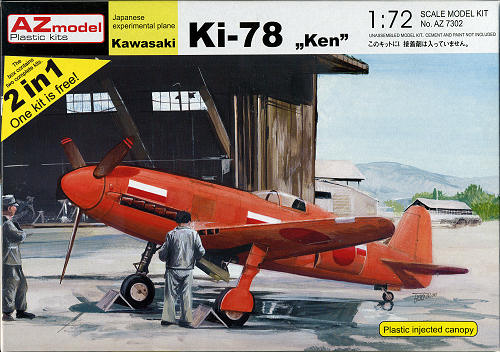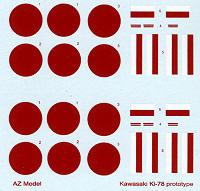
AZ Model 1/72 Ki-78 'Ken'
| KIT #: | AZ 7302 |
| PRICE: | $21.35 from www.greatmodels.com |
| DECALS: | Two Options |
| REVIEWER: | Scott Van Aken |
| NOTES: | Short run |

| HISTORY |
At first glance, this airplane can easily be mistaken for a modified version of the Kawasaki Ki-61 Hien fighter. In fact, it was no fighter a all, but a high-speed research plane to investigate laminar profile wings with a very high wing-loading. It was also the intention to break the world speed record. Initiated before the outbreak of the second world war, it never performed as expected.
Early 1938 a high-speed research program was started for a small single-seat airplane with the designation KEN III, where KEN stood for Kensan, the Japanese word for ‘Research’. It was a mutual project of the Aeronautical Research Institute of the University of Tokyo and Kawasaki to investigate flying behavior at very high speed. It was also the intention to use the new plane for setting a new world record for speed. Responsible for the design of the new record plane were Shoroku Wada as team leader and Mineao Yamamoto for the fuselage design. Further, Eichiro Tani and Seichi Kurino were responsible for wing design and engine installation respectively.
The new plane featured a well-streamlined fuselage fitted with a license-build German Daimler-Benz DB 601A engine. For extra power, methanol/water injection was used. All-metal construction was used in combination with a small and thin wing with a laminar flow profile with a knife-sharp leading edge. With its very small wing area of only 11 m2, new lift devices were used that were never used before on Japanese planes. To reduce the landing speed, a combination of Fowler and split flaps were used. To give the Daimler-Benz engine sufficient cooling, two shallow cooling ducts were fitted on each side of the rear fuselage. To give the cooling air a good airflow, a ram-air feeding system was developed using a cooling fan driven by a 60 hp engine.
By the outbreak of the war, the whole project was taken over by the Imperial Japanese Army, who gave it the military type designation Ki-78. The full-size mock-up of the Ki-78 was completed in May 1941.
Under supervision of Isamu Imashi, Kawasaki received the order to build two prototypes of the Ki-78. Construction was started in September 1941. The first was completed in the Gifu factory more than a year later. It was flown for the first time on 26 December 1942. At the low end of the flight envelope, the Ki-78 was found to have very tricky stall characteristics. Further it was found to be difficult to fly. Take-off speed was an incredible 205 km/h, while the landing speed was 170 km/h in spite of the use of the high-lift devices. At high speed, flutter of the elevators was encountered above 600 km/h. This was more or less cured by fitting a horn-balance. In April 1943 full-speed flight performance testing could be started, however with disappointing results. Instead of an expected maximum speed of 850 km/h, highest speed measured was 700 km/h at 3527 m at its 31st flight on 27 December 1943. The flight performance program was terminated in December 1943.
A feasibility study to improve the KI-78 flight performances showed that extensive airframe modifications were needed and as a consequence the project was officially terminated after the 32nd flight on 11 January 1944.
The second Ki-78 was never built.
| THE KIT |
 First
thing I noticed is that the box is about twice as big as needed for the kit.
Second thing I noticed is that there are two kits! Pretty neat considering
only one aircraft was ever built, but it does allow you to model it in both
paint schemes or do a whiffer with the second one.
First
thing I noticed is that the box is about twice as big as needed for the kit.
Second thing I noticed is that there are two kits! Pretty neat considering
only one aircraft was ever built, but it does allow you to model it in both
paint schemes or do a whiffer with the second one.
Any way, the kit comes on one sprue with one piece wings and
tail planes, an interior that has a seat, instrument panel and floor (you'll
need to stretch sprue for the control stick and for the landing gear retraction
struts), as well as a one piece prop and wheels. There are fore and aft pieces
for the side radiators along with nicely done landing gear bits. At least,
nicely done for a short run kit. An injected canopy is also supplied. I did find
som e
depressions behind the wheel wells on the rather thick one-piece wing and there
are some ejector towers you may wish to remove. The kit does provide some interior sidewall detail.
e
depressions behind the wheel wells on the rather thick one-piece wing and there
are some ejector towers you may wish to remove. The kit does provide some interior sidewall detail.
Instructions are basically seven nicely drawn construction steps on one side of a piece of paper with a parts layout and four view drawing on the other. Color and marking info is on the back of the box in full color. There is no interior color information or any color info in the construction drawings. You basically can do the aircraft in unpainted metal with a black anti-glare panel or in 'E-18 Orange' as was the norm for prototypes and trainers. The decal sheet has two identical sets of markings. For those wanting to do whiffer aircraft, this would probably be painted Kawasaki Green upper and green grey undersides with yellow wing ID bands.
| CONCLUSIONS |
For those of you who, like me, are doing a series of Ki (pronounced 'key') aircraft, this one is a must have. It looks simple enough (famous last words) and will not take up much in the way of shelf space.
| REFERENCES |
http://www.letletlet-warplanes.com
November 2010
You can get this and other neat kits and accessories at GreatModels
If you would like your product reviewed fairly and quickly, please contact me or see other details in the Note to Contributors.
Back to the Previews Index Page